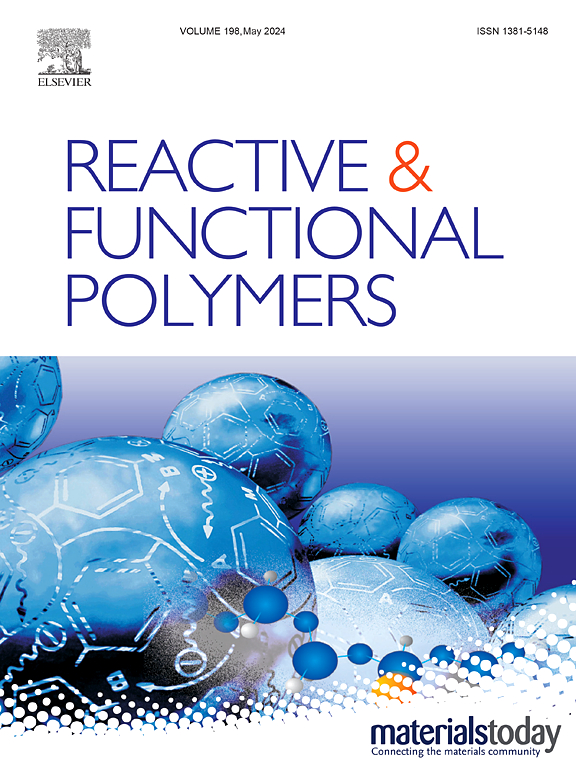Comprehensive performance improvement and functional upgrade of Magnolia-based epoxy resins
IF 4.5
3区 工程技术
Q1 CHEMISTRY, APPLIED
引用次数: 0
Abstract
The magnolol- (MEP) and honokiol-epoxy resin (HEP) were prepared from the extract of the natural plant Magnolia officinalis. Those monomers were cured with hardeners, such as 4,4-diamino diphenyl sulfone (DDS) and 4,4′-bis (3-aminophenoxy) diphenyl sulfone (BDS), respectively via solvent-free process to fabricate networks with excellent mechanical properties. The curing procedures occurred in a wide temperature interval (65 °C), which made the concerning vacuum-assisted resin infusion feasible. Notedly, all combinations exhibited increased thermal stability (Td5, 359.7–381.9 °C) with Tmax fluctuating around 450 °C. The phase transition temperature (Tα) screen suggested that except MEP/BDS (Tα, 147.2 °C), other combinations varied from 264.2 °C to 281.2 °C. In addition, DDS allowed the networks with slightly lower thermal expansion coefficients (CTE, 68.1 ppm/ oC, <180 °C for HEP/DDS), while the BDS yielded relatively high CTE values (87.1 ppm/ oC, <106 °C, for MEP/BDS). The LOI value (33 %) and vertical burning test (UL-94) indicated their outstanding flame retardancy (UL 94 V-0). Furthermore, for MEP/BDS, the unique solvolysis (in DMF or THF) and thermally induced shape memory properties along with the superior flame retardancy demonstrated its overall high performances. As a whole, these performance improvements further facilitate the high-end applications of sustainable resins in cutting-edge areas.

木兰基环氧树脂的综合性能改进与功能升级
以天然植物厚朴提取物为原料制备厚朴酚- (MEP)和厚朴酚-环氧树脂(HEP)。这些单体分别用硬化剂4,4-二氨基二苯基砜(DDS)和4,4 ' -双(3-氨基苯氧基)二苯基砜(BDS)通过无溶剂固化法制备了具有优异力学性能的网络。固化过程发生在宽温度区间(65°C),这使得有关真空辅助树脂注入是可行的。值得注意的是,所有组合都表现出更高的热稳定性(Td5, 359.7-381.9°C), Tmax在450°C左右波动。相变温度(Tα)筛选表明,除MEP/BDS (Tα, 147.2℃)外,其他组合在264.2 ~ 281.2℃范围内变化。此外,DDS允许网络具有稍低的热膨胀系数(CTE, HEP/DDS为68.1 ppm/ oC, <180°C),而BDS产生相对较高的CTE值(87.1 ppm/ oC, <106°C, MEP/BDS)。LOI值(33%)和垂直燃烧试验(UL-94)表明其阻燃性(UL 94 V-0)优异。此外,对于MEP/BDS,其独特的溶解性能(在DMF或THF中)和热诱导形状记忆性能以及优异的阻燃性显示了其整体高性能。总体而言,这些性能改进进一步促进了可持续树脂在尖端领域的高端应用。
本文章由计算机程序翻译,如有差异,请以英文原文为准。
求助全文
约1分钟内获得全文
求助全文
来源期刊

Reactive & Functional Polymers
工程技术-高分子科学
CiteScore
8.90
自引率
5.90%
发文量
259
审稿时长
27 days
期刊介绍:
Reactive & Functional Polymers provides a forum to disseminate original ideas, concepts and developments in the science and technology of polymers with functional groups, which impart specific chemical reactivity or physical, chemical, structural, biological, and pharmacological functionality. The scope covers organic polymers, acting for instance as reagents, catalysts, templates, ion-exchangers, selective sorbents, chelating or antimicrobial agents, drug carriers, sensors, membranes, and hydrogels. This also includes reactive cross-linkable prepolymers and high-performance thermosetting polymers, natural or degradable polymers, conducting polymers, and porous polymers.
Original research articles must contain thorough molecular and material characterization data on synthesis of the above polymers in combination with their applications. Applications include but are not limited to catalysis, water or effluent treatment, separations and recovery, electronics and information storage, energy conversion, encapsulation, or adhesion.
 求助内容:
求助内容: 应助结果提醒方式:
应助结果提醒方式:


